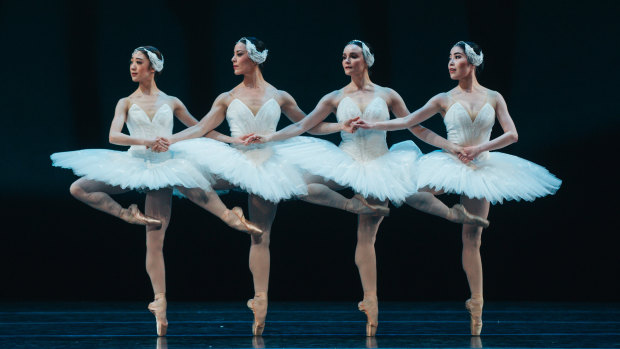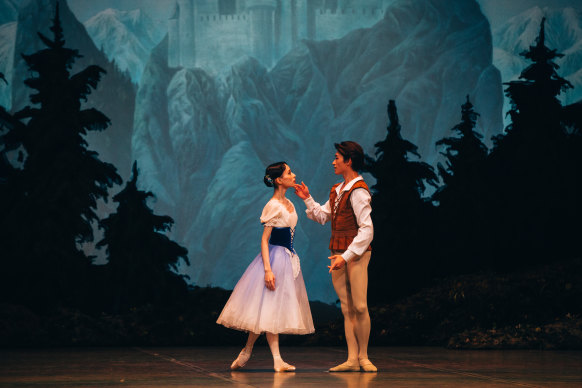When I did ballet, my doctor would ask: ‘So, what’s wrong with you aside from the anorexia?’

Save articles for later
Add articles to your saved list and come back to them any time.
Eating disorders and the dance industry have felt synonymous for years. As someone who spent almost two decades in the industry, believe me, I know. In the depth of my ballet training, my doctor would ask me “so, what’s wrong with you aside from the anorexia?”
Generally, dancers are petite due to the sheer physical demands of the art form. Hours of daily training combined with nightly performances can result in a lean and muscular physique, but not always or for all dancers.
Australian Ballet dancers in the 2023 production of Swan Lake.Credit: Kate Longley
What’s more, it’s no secret that a thin frame is the preference in body type throughout the industry. Ballerinas are told it’s so that fat doesn’t get in the way when your leg is placed next to your ear, or so that your feet aren’t stressed from your body weight when you’re en pointe (standing on your toes). These beliefs are drilled into you from a very young age, and it is tacitly understood that the only way to “make it” is to look like a stick.
Earlier this month, the BBC reported accounts of bullying and body-shaming at two of the UK’s top-performing dance schools. Speaking to over 50 ex-students of the Royal Ballet School and Elmhurst Ballet School – which have educated some of the world’s best dancers, like Margot Fonteyn, Darcey Bussell, Jonathan Cope and Melissa Hamilton – it found that many developed eating disorders and/or mental health problems as a result of their training.
The reporting blew up on social media, with many current and former dancers from around the world sharing similar experiences of the mental and physical strain they were put through to abide by ancient rules set by teachers or authority figures in the industry.
Then, last week, Australian former dancer at the Royal Ballet Company turned ballet school director Claudia Dean took to TikTok and spoke about how dance education needs to move forward and shake off its traditionalist ideals. How dated views of what a ballerina should look like are damaging young hopefuls.
I fell in love with ballet the moment I stepped foot in a studio at three years old. The costumes attracted me at first, but then I learnt to love the meditative practice of aiming towards perfection. The daily grind and adrenaline rush from being on stage made all the hours of training worth it.
After graduating from high school, I turned to full-time training before jetting off to Belgium, Moscow and New York to try my luck professionally. But audition after audition, I was turned down for various reasons; being of Asian descent, being two centimetres too short, not having the correct visa. Eventually, at the age of 22, I hung up my pointe shoes for good.
I have memories of my class being called in for an emergency meeting in our dressing room when I was 18. Bar a select few, we were slammed by teachers for being chubby and were encouraged to go on a blood type diet to ensure we weren’t consuming foods deemed inappropriate for our bodies.
When I travelled up to Moscow to be part of the Bolshoi Ballet Academy, a height and weight chart was thrust upon us the moment we stepped foot in the school. The same diet and weight restrictions were to be applied to students aged from 10 up to 22. Girls who weighed over 50 kilograms were banned from taking part in partnered classes.
Day after day, I was encouraged to lose weight and told I had messed up routines because I was “fat”. My teacher instructed me that to meet her ideal, I should eat only before midday. I was told to consume only tomatoes and to drink tea to fill the void.
A blind eye was turned when dancers, whose bodies were so weakened by sustained dieting, were given sniffing salts from nurses in a bid to shock their weakening hearts back into action. So, too, was the prolific use of laxatives by both male and female students. We all took up skipping and began running around the hallways wearing warm-up attire, like hamsters stuck in a perpetually moving wheel.
Even though I was never officially diagnosed with an eating disorder, thoughts of food and weight were unrelenting.
Akira Akiyama and Yasuomi Akimoto of the Tokyo Ballet perform in Giselle.Credit: Kate Longley
A systemic shake-up is long overdue in the ballet industry. The lasting effects from years of bullying, deprivation and rigidity at any cost seep into all aspects of a dancer’s life, even after they leave or retire. Without an evolution, ballet will be left behind by more evolved art forms to die a slow and painful death.
Emma Sullivan is a freelance writer and works in social media marketing in the arts.
The Opinion newsletter is a weekly wrap of views that will challenge, champion and inform your own. Sign up here.
Most Viewed in Culture
From our partners
Source: Read Full Article

